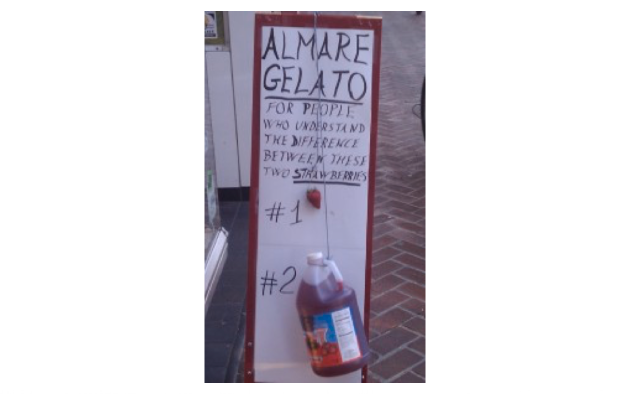An eatbigfish exercise to help dramatise your differences
Most people give brands much less attention, let alone consideration, than we’d like to believe. Here's an exercise to help you make your differences really dramatic.
I have a friend who has a strategy for hotel check-ins. As soon as she reaches the front desk for the first time she leans across to the unsuspecting receptionist and says: ’Look. Don’t give me the room you were going to give me. Don’t give me the room you were going to give me when I complained about that first room you were going to give me. Give me the room you would have given me when I complained about that other room and asked to see your manager. It’ll just save us all a whole lot of time’.
It works surprisingly well.
I am reminded of that story when I look at my favourite piece of advertising of the last five years. It’s an A-frame board outside an ice cream shop in the US, that a friend sent me:
Think about what might have written on that board instead of this, around their commitment to quality. ‘All our products are made with real ingredients’, perhaps. True, and admirable, but entirely Ho-hum. A difference no one would notice.
We might in their position have felt that was too anaemic, though; this is our primary advertising medium, after all. Let’s ratchet it up a bit, we say to ourselves – put some emotion into those words. Consider capitals. Exclamation marks, even. ‘We HATE artificial flavours. Only made with real strawberries!’. Get a decent signwriter to do a bang-up job of getting all that down on our board.
And no one would have paid any attention to it.
What makes this so, so much better than any of that? That lo-fi four litre bottle of red artificial gunk nailed to the board (the sheer quantity of the bloody stuff). The piece of cord that it hangs from – is it just angrily nailed in on the other side?. The roughly written #1 and #2. The raw ferocity of the comparison, and the ‘do you care about this stuff or not?’ challenge. How can you not notice it? How can you not respond to it? How can you not feel that they are different, that this is a difference that really matters, and that this is a difference that they really care about?
Challengers have to dramatise their differences. Most people give us much less attention, let alone consideration, than we’d like to believe. And what we as brand owners see as significant differences in our packs or ads the consumer often scarcely notices at all. One of the things that characterizes many of the challengers in food, for example, is their rather over the top personality, or full frontal product comparisons – some even using their core product format to symbolise their key point of view.
Tony's Chocolonely's unevenly divided bar represents the social inequality the company is fighting against.
Why? They have big ambitions, little budget and a consumer who’s not looking for them. They have to dramatise their differences if they want some traction.
And boy, does Amare Gelato dramatise theirs.
Which brings me back to my friend at the hotel check in. What if we wanted to explore how to dramatise our key point of difference, assuming that we know what it is?
Exercise
Let’s imagine we have only one piece of communication - a single A-frame board – and everything hinges on that. Let’s assume there are three different levels of drama we can use to communicate what our difference is:
Ho Hum
This is probably what we are saying at the moment, or the way we are saying it. Worthy, true, but mostly unnoticed by the casual observer.
Am Dram
The next level up. This is what it would look like if we dialed up the drama a little. Accentuate the key thing. Primarily verbal. Possibly some visuals of some kind.
Encore
This is what we’d get if we were taken over by the people at Amare Gelato. Physical drama, pushing the natural boundaries of the medium. Contrast. Perhaps a challenge of some kind. A question to which there can be only one possible answer.
Let’s map out what those three different levels of drama around our difference would look like. Ask ourselves which of them we really need to lean into to be noticed, considered, picked up.
And then take it into the medium that is most important to us.


